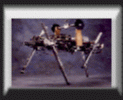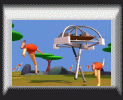Milestones of the Leg Laboratory
- 1979
- Ivan Sutherland provides slush funding so Raibert could build
first hopping machine.
- 1980
- ARPA decides to fund development of hopping machine.
- 1982
- Planar one-legged machine hops in place, travels at a specified
rate, keeps its balance when disturbed, and jumps over small obstacles.
- 1983
- Three-dimensional one-legged machine runs and balances on an open
floor. Simulations reveal passively stabilized bounding gait for
quadruped-like model.
- 1984
- Quadruped runs with trotting gait using generalization of one-leg
algorithms. Data from cat and human found to exhibit symmetries like those
used to control running machines.
- 1985
- Planar biped runs with one- and two-legged gaits and changes
between gaits.
- 1986
- Planar biped does flips, aerials, and runs at 11.5 mph. Monopod
runs using leg with rotary joint and leaf-spring foot.
- 1987
- Quadruped runs with trotting, pacing, and bounding gaits.
- 1988
- Planar biped uses selected footholds and climbs short stairway.
Quadruped does rudimentary transitions between running gaits. Reentrant
trajectories found for simulated passive dynamic running. Computer simulation
shows running in zero-g by bouncing between two floors. Simple physical model
of zero-g running demonstrated.
- 1989
- Planar biped jumps through hoop and runs with top speed of 13.1
mph. Simulated planar biped gallops. Hoof added to monopod improves
performance of leafspring foot. Three-dimensional biped does simple running.
- 1990
- Planar biped robot walks, gallops, and changes between walking and
running. Simulation of passive dynamic running with knees.
- 1991
- Kangaroo-like robot (Uniroo), with articulated leg and tail, takes
first steps (hops). Computer simulations of simplified kangaroos and
ostriches.
- 1992
- 3D biped robot does somersault.
- Uniroo runs at 1.8 m/s.
- Simulatedquadruped control system adjusts automatically for
variations in body mass and leg length.
- 1993
- 3D Biped and Uniroo appear with Sean Connery and Wesley Snipes in
Rising Sun.
- Passive stability achieved for layout somersault in laboratory "doll".
- 1994
- Cockroach simulations runs using kinematic motion data from animal.
Stable Groucho running in simulated spherical cockroach (Hexahopper).
- Weight-shifting robot rocks with stability.
- 1995
- Spring Turkey, a planar bipedal robot, walks at 0.5 m/s using
Series Elastic Actuators and Virtual Model Control.
- 1996
- Planar Quadruped runs with articulated spine.
- Agile hexapod simulation walks over rough terrain while
balancing a pendulum on its back.
- 1997
- Spring Flamingo, a planar bipedal robot, walks utilizing
feet and actuated ankles.
The Leg Laboratory was located at Carnegie-Mellon University from
1980-1986, and at the Massachusetts Institute of Technology from
1987-present.






 Back to the Leg Lab Home Page
Back to the Leg Lab Home Page
©
1995 MIT Leg Laboratory. All Rights Reserved.
Most recent update: 2/11/96